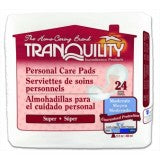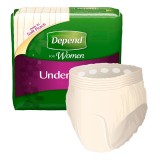Your Cart is Empty

Reasons Why You Should See a Doctor for Urinary Incontinence
Overactive Bladder in Women
Incontinence after Pregnancy
Incontinence and Menopause
Exercise-Induced Incontinence
How to Choose an Incontinence Pad
The Difference between Menstrual Pads and Bladder Control Pads
Incontinence Products for Women
Kegel Exercises for Women

Reasons Why You Should See a Doctor for Urinary Incontinence
Feeling embarrassed about a bladder control issue isn't a good reason to not see a doctor. Also, don't fall for the myth that, just because you had children or are getting older, incontinence is a given—plenty of mothers and older women have no such problem. There are lots of good reasons why you should consult your healthcare provider about your loss of bladder control:
Most importantly, knowing and understanding the root cause of your bladder problems will alleviate stress. After all, you have to know what the problem is in order to begin to solve it. You can also take comfort in the fact that, in the meantime, there are plenty of protective products available to help you cope with the issue.

Overactive Bladder in Women
Overactive bladder (OAB), also known as "urge incontinence," affects nearly 34 million people, most of whom are women. The cause of OAB is unknown. In those who suffer from it, the bladder spasms, resulting in frequent and sudden urges to urinate. Most people with OAB have accidents because the urge comes so quickly and intensely that they can't make it to the bathroom in time.
It's important to remember that loss of bladder control is not a disease, but rather, a symptom. An accurate diagnosis of your specific urinary control problem is the key to proper treatment. Get educated about incontinence issues, work with your healthcare provider to establish a treatment plan, and protect yourself with absorbent products that will bring you both physical comfort and peace of mind. Bladder control pads for example, look similar to menstrual pads and panty liners, but are actually far more absorbent and utilize technology created specifically to absorb and neutralize urine.

Incontinence after Pregnancy
The majority of people who suffer from urinary incontinence are women. Two major contributors to female incontinence include pregnancy and childbirth. The added pressure and stress that's applied to the internal organs and muscles of the lower abdomen and pelvic floor during pregnancy can have a negative effect on the function of the bladder and sphincter. Additionally, the weight of the fetus in the uterus pulls the internal organs downward, which tends to stretch everything out. Unfortunately, things don't always bounce back after childbirth. During childbirth, there may be trauma to the vagina and rectum, which can affect the flow of waste, and the stretching that allows the baby to pass through the birth canal may also remain stretched afterwards.
The result of all the stretching and added pressure is usually stress incontinence. This means that laughing, sneezing, and coughing can cause a leak. Some women opt for surgery to improve the internal support of the bladder and pelvic floor. Others correct the problem through Kegel exercises, which help strengthen the pelvic floor muscles in order to improve bladder control. Pelvic muscle trainers are available to help make sure the exercises are properly performed and to provide added resistance training.
Regardless of which approach you take, following your healthcare provider's advice and using protective undergarments will ensure that you remain comfortable and prepared for any unsuspecting leaks. For the light bladder leakage that can follow pregnancy and childbirth, try products like Depends protective underwear, Serenity pads, or Poise pads.

Incontinence and Menopause
Although urinary incontinence can occur at any age during a woman’s life, many women will begin to notice incontinence symptoms around the start or beginning of their menopausal years. In fact, more than 40 percent of menopausal women experience some form of urinary incontinence. Some bladder control problems caused by menopause include: stress incontinence, urge incontinence, and nocturia, or frequent urination at night.
Estrogen is a hormone that contributes to a healthy bladder and urethra. But as women age into menopause, estrogen levels decrease, causing women to experience poor bladder control. Low estrogen levels affect blood flow to the pelvic muscles, which cause the lining of the vagina and urethra to become thinner, drier, and more at risk for infections. In order for the urethra to prevent urine leaks, it needs a certain degree of elasticity and moisture.
Strengthening pelvic floor muscles through kegel exercises can help menopausal women manage incontinence symptoms. Women can also learn to retrain their bladder by increasing their bladder’s capacity to hold urine. To do this, choose an interval of time to use the bathroom and then strictly follow that schedule throughout the day. For example, start by using the bathroom every hour and a half. Use kegels to resist urges when you’re not schedule to void, and go when you are scheduled to, even if you don’t need to. As your pelvic muscles get stronger, gradually increase your time interval.
It’s also important for menopausal women to exercise and stay active as the pelvic floor muscles will only get weaker with age. Using incontinence protection, such as bladder control pads and disposable underwear, can help women stay dry and comfortable.

Exercise-Induced Incontinence
There are several types of incontinence that affect women. One particular form of stress incontinence is associated with physical activity: exercise-induced incontinence.
Like any other type of incontinence, the resulting embarrassment prevents some female athletes, even elite athletes, from mentioning that they have experienced this condition at all. In fact, it may become such a problem that they actually give up the sport or activity they love because of the frustration of ongoing urine leaks.
During intense physical activity or exertion, intra-abdominal tension increases. If the breath is held while exerting a maximal effort, such as that required to lift heavy weights or sprint at top speeds, the pressure created is called the Valsalva maneuver. The tension from this maneuver presses on the internal organs, including the bladder. And, since neurological and vascular activity in the body is directed to the large muscle groups that are working, the muscles that control bladder output aren't working. This compromises the ability of the bladder and urethra to control the exit of urine. The result is bladder leakage.
Kegel exercises, which are used to strengthen the pelvic floor muscles, are the best means of protection against exercise-induced incontinence. Until that muscle support kicks in, wearing a protective pad during physical activity is a good way to avoid the frustration and inconvenience of an unexpected urine leak.

How to Choose an Incontinence Pad
For women experiencing light bladder leakage, or mild incontinence, bladder control pads can help you stay protected and feeling confident. Incontinence pads conform to the body and are thin and discreet so no one will notice that you are wearing one. They generally feature a special material that wicks urine away from the skin, keeping the user dry, comfortable, and odor-free. Worn on your own underwear, incontinence pads are used for daytime protection, although some pads are absorbent enough to use during the night. Pads come in a variety of sizes, lengths, and absorbencies, and some, like the Abena AbriSan pads, come with side guards to prevent leakage. It’s important to take these features into consideration when choosing a pad.
Poise pads are a popular option for women because they range in absorbencies from ultra-thin to ultimate and feature a Blue Absorb LocCore that holds moisture and neutralizes urine odors. Some bladder pads can even be worn in conjunction with incontinence briefs or washable pants for increased incontinence protection. For example, Tena Pads are a customer favorite that allows for air circulation and comfort and can quickly absorb fluid so you stay well protected and dry. They can be used with the washable Tena Pants or worn with regular underwear.
Make sure to keep a few pads in the office, in your purse or bag, and in your car for quick, easy access. With incontinence pads, you won’t have to worry about an embarrassing leak next time you sneeze, laugh, or exercise.

The Difference between Menstrual Pads and Bladder Control Pads
Menstrual pads and incontinence pads are pretty similar, in that they look the same, stick onto your own underwear, and absorb fluid quickly. So what’s the difference? Why shouldn’t you use a menstrual pad to help manage your bladder control problems?
The main difference between the two pads is the type of fluid they’re meant to absorb. Menstrual pads are designed to absorb menstrual flow, which comes out much slower than urine. Bladder control pads, on the other hand, are designed to absorb the rapid dispersion of urine. They’re made with polymer fabrics that pull moisture away from the skin so that you stay dry, comfortable, and odor-free. Bladder control pads neutralize acidic urine, which can cause skin rashes if left unchanged. Some incontinence pads, such as Prevail Pads, feature a special gel that prevents skin infections caused by long exposure to urine.
So although you may be tempted to use sanitary napkins to help with urinary leakage, they won’t offer the same level of protection and comfort as incontinence pads.

Incontinence Products for Women
In addition to bladder pads, women have the option to choose from a wide selection of incontinence products, from stylish protective underwear to basic adult diapers. Since many manufacturers are changing the look and feel of incontinence supplies to resemble real underwear, women can stay confident while managing their bladder control problems.
Adult briefs, also known as adult diapers, are useful if you are limited in mobility or need help getting to the bathroom or changing yourself. Disposable diapers offer maximum daytime and nighttime protection for those experiencing heavy incontinence. They usually come with refastenable tabs, which make it easy for caregivers and users to change while standing or lying down and without having to completely remove clothing.
Protective underwear are a great and comfortable option for those who don’t require assistance in changing and want incontinence protection that looks and feels like real underwear. Women will feel confident in these protective undergarments because they can be pulled up and down like regular underwear. Pull on underwear feature breathable fabric and a highly absorbent core so that women stay comfortable and protected where they need it most.
National Incontinence carries a variety of Depends for women, including Depend Underwear for Women and the Depend Silhouette Brief. For those who want something more colorful and feminine, the Depend variety pack comes with absorbent underwear in pastel colors and floral patterns. Tena Underwear for Women is another option for those who need moderate to heavy protection. This disposable underwear is made of a soft cotton material and an elastic waistband for a snug fit.
Whichever brand or style of adult brief or protective underwear you choose, rest assured that you will stay well protected and free of embarrassing leaks.

Kegel Exercises for Women
The most common non-surgical incontinence treatment for women is pelvic floor exercises, also known as kegels. Many women experience a loss of bladder control due to weak pelvic floor muscles – most likely caused by pregnancy, childbirth, or menopause. Kegel exercises target the pelvic muscles and strengthen them so that you regain the bladder control you once had. One side effect of preforming Kegel exercises is that it can enhance sexual pleasure.
National Incontinence offers two kegel exercisers for women: vaginal weights and the Kegelmaster. Vaginal weights are cone-shaped objects that vary in weights. You insert one into your vagina, like a tampon, and flex your pelvic floor muscles to keep the cone from falling out. As your pelvic muscles get stronger, you increase the weight of the cone. The goal is to prevent the cones from slipping out while moving and doing your daily activities.
The Kegelmaster is another exerciser that is inserted into your vagina. The device uses springs to increase tension and resistance to your pelvic floor muscles. You then flex your pelvic floor muscles to squeeze the device together.
Kegel exercises are discreet and doing them at least 15 minutes, twice a day can vastly improve your bladder control. You can perform kegels while sitting or lying down; however, doing them standing up can provide the best results. Women of all ages can perform kegel exercises; however, they are not recommended for women who are pregnant, menstruating or experiencing pelvic pain.